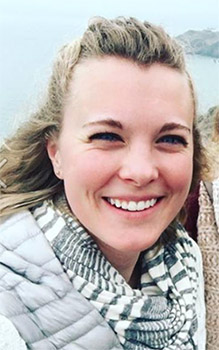
Anna Davis
Today’s younger generation is often known for having short attention spans. They want their news short and immediately. But it’s for exactly this reason that Texas A&M senior Anna Davis enjoyed listening to testimony through USC Shoah Foundation’s Visual History Archive.
“I couldn’t skip through to find the highlights. I couldn’t look up a summary. Listening to and soaking in the realities of these testimonies put me in proximity with the events of the Holocaust that wouldn’t have otherwise been possible,” Davis said. “It provokes in the viewer a sense of looking at something — really taking it in — and though it is horribly traumatic, you ought not to look away.”
Davis had a reason to dive into the VHA for a class she took in the fall semester of 2015, “History of the Holocaust,” with Professor Adam R. Seipp, USC Shoah Foundation’s first-ever Texas A&M Teaching Fellow.
For the course, students were placed in groups that were assigned to research, present and write about a certain aspect of the death marches from the Dachau concentration camp. Davis’s group covered the actual people marching themselves — discussing what the marchers’ backgrounds were like, how they ended up at the Dachau Camp, and their future lives post-Holocaust.
Because of her performance in the class, Seipp asked Davis to be part of a panel of students who spoke at the university’s Hillel in April for a discussion on “Testimony, Memory and the Holocaust.” The panel followed a presentation by USC Shoah Foundation Center for Advanced Genocide Research Director Wolf Gruner and VHA Curator Crispin Brooks.
“I spoke at length about … how the VHA allows the testimonies of these survivors to put a face to a name,” Davis said. “By looking at individual stories of survivors, we are able to glimpse the reality and actuality of the Holocaust, not just glance over it with a sterile number.”
Taking Seipp’s course allowed Davis to pursue an interest she had had since a young age.
“As a child, if I was ever flipping around on the television and came across a movie or documentary on the Holocaust, I would stop and watch,” she said. “I don’t know what it was about it, but it always held my gaze and attention.”
The history minor found that the VHA testimonies had a similar effect on her, but in an enhanced, more active way.
“The testimonies allowed me to participate in a kind of interactive remembrance,” she said. “That is a kind of remembrance that is not just passive observation. It is an intentional gaze at something that needs to be looked at and addressed, not just glanced at with shifting eyes.”